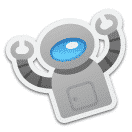

- Open systems which are accessed by anyone who has an account (free or paid) with the group
- Closed systems, also called line of business applications, that usually cannot be accessed by anyone outside of those people it was created for
Who are the Users?
Regardless of whether you are designing an open or closed system, be sure the user interface meets the needs of the people it is created for. Consequently, it’s vital that you know the users. Remember, it is people, not robots, who will be using the UI. There are three ways you can identify the users:
- User interviews
- Business stakeholder interviews
- The shadowing method of observation which requires watching and noting the users steps.
If you are unable to interact with the users, then create personas that represent real user’s habits, goals or motivations. These will help you design an effective UI sure to delight all who will be using it. In addition to creating personas, you can also use task analysis, which identifies what jobs users perform, how they do them, how long they take and what mistakes are made. However, be sure to keep in mind, that regardless of the group you are designing user interface(s) for, there will be novices and experts and each will have their own set of needs.
User Interface Principles of Design
According to UI pros like Lucy Lockwood, Larry Constantine and Janko Jovanovic, there are several basic principles for all user interfaces. So when creating UIs keep these 6 principles in mind.
- Consistency-from navigation to color, being consistent lets users know what to expect.>
- Efficiency– the UI should allow users to accomplish tasks easily and quickly. This is done by:
- Providing keyboard support and shortcuts
- Personalization-this helps users to learn the UI application more quickly
- Make it accessible to the users
- Be sure UI provides beneficial feedback, so users are aware of errors and how to recover
- Have help systems such as guided tours, videos, support databases or other interactive methods.
- Structure– The UI should be well organized so that it is easy to put together related items.
- Simple– Easy to use with shortcuts that are meaningfully related to longer procedures; in addition, it should not confuse or overwhelm users with too many choices or unneeded information.
- Tolerant– The design should be flexible and forgiving, correcting errors whenever possible while preventing errors at the same time
- Feedback– The design should keep users aware of actions, changes in the UI, errors or exceptions through simple to understand language.
The Design Process
While there are several UI design processes, the most recommended approach is the “Agile” approach which incorporates the Iterative Principle. The Iterative Principle ensures that each phase is tested as you go. Theses phase are sketching, prototyping and testing.
- Sketching allows you to try out ideas and see which ones will or will not work
- Prototyping is used to simulate the real application. It may contain none, many or all of the features of the final application; however, since these are usually in HTML (though some people may use PowerPoint) you do not have to include all the coding.
- Testing– this should be done early and often so you can be efficient. It will also help you stay on budget by not putting unnecessary time/energy into something that will not actually be used.
Designing an application UI that is successful also means making sure it is user friendly. There are many ways to do this, so be looking for the next post, which will help you create more effective user interfaces in your applications. Of course, if you are interested in having a UI designed for your company, then give us a call here at Page Progressive, we would love to hear from you.